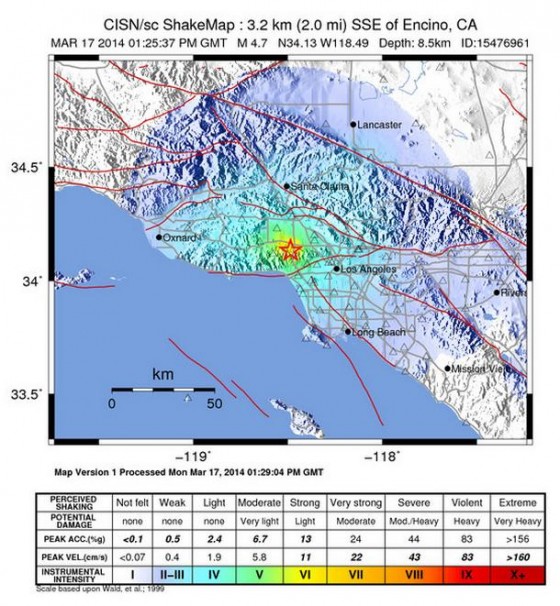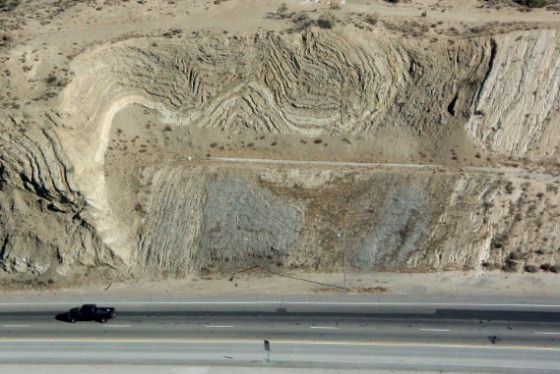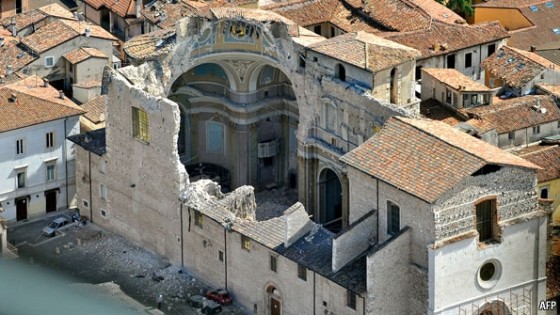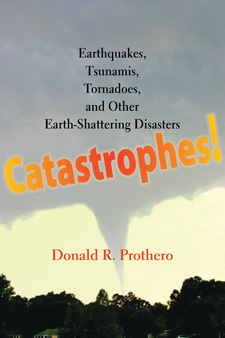by
Donald Prothero, May 21 2014
As I wind down the semester teaching six different classes in introductory geology and oceanography at three different colleges, I’ve found myself explaining in nearly every lecture the difference between the real world and the popular mythology that appears in the movies, television, and the cartoons. Since nearly everything the general public thinks they know about science seems to come from bad Hollywood movies and TV shows, it’s not surprising that these myths are perpetuated, and our scientific literacy is so abysmal.
This is not a new topic, of course. Physicists and astronomers have long complained how badly most sci fi movies and TV and novels mangle science (starting with the impossibility of transmitting sound in the vacuum of space, which nearly all the space movies get wrong—but explosions without sound simply don’t do it for today’s audiences). I know of some geology departments that have “Bad geology movie” nights, where they play older films and laugh at all the ridiculous things they say about the earth. (In fact, nearly every Hollywood movie gets the geology all wrong). But I’ve been a scientist since I was hooked on dinosaurs at age 4, and consequently I’ve never enjoyed movies that distort or violate the rules of science. Websites like TVtropes.org document the wide range of stupid or silly things that show up regularly in movies or TV, and how little reality or science influences the decisions of scriptwriters. Of course, this is basic Scriptwriting 101: the story arc of the plot, the development and interaction of characters, and many other things take priority over keeping the movie within the bounds of scientific reality. I’ve been a scientific consultant on enough shows to know that what I say is only a guideline, and the story and characters take precedence over reality. Still, in many or most cases, the movie plot would work just fine with a realistic portrayal of science, but that rarely happens. After all, screen writers tend to be no more literate about science than their audiences, so to a large extent they don’t know that all these cliched ideas are false—and most don’t seem to care, even if it is explained to them. As TVtropes.org puts it, it’s the “Rule of Cool”: audiences will forgive gross scientific inaccuracies and completely implausible action if it makes the movie more spectacular and enjoyable. Continue reading…
comments (22)
by
Donald Prothero, Mar 19 2014

Shaking intensity map of the March 17, 2014, Sherman Oaks quake
As Saint Patrick’s Day was beginning to dawn here in Los Angeles, most people in the central and western side of the city were abruptly awakened just after 6:30 a.m. by a 4.4 magnitude quake on the north side of the Santa Monica Mountains, near Woodland Hills, where I teach geology at Pierce College. It awoke my family during the 2-5 seconds of shaking, but I slept through it. I’ve been through the 1971 Sylmar quake, the 1987 Whittier quake, the 1994 Northridge quake—every major quake here since I was born in the region, so a piddling 4.4 doesn’t even rattle me. I even was lucky enough to experience a rare Eastern earthquake when I felt the Virginia quake of August, 2011, from the top floor of the Frick Wing of the American Museum of Natural History.
We immediately turned on the news and got the basic information about the quake, as the magnitude was downgraded from 4.7 to 4.4 when better data came in, and the location was moved from Westwood to Sherman Oaks, closer to the actual fault line on the north side of the Santa Monica Mountains. Most of the reporting was competent, although in the early stages, it’s largely silly stuff like “Did you feel it?” and “What did it feel like?” rather than anything accurate or scientific that would tell us something important about the quake. Sure enough, sooner or later it was bound to happen: one of the “man-on-the-street” interviewees spouted the geologists’ least favorite myth: “Oh, it was warm yesterday, so there must have been earthquake weather.” Fortunately, the news anchor was smart enough to dismiss this urban myth and move on to another interview, but if you surfed the internet, it was full of claims that “earthquake weather” must have caused this quake. (Geologists’ other pet peeve: people—especially news anchors and reporters—using the term “tidal wave” for tsunamis, which have nothing to do with tides. Fortunately, the lessons of the Dec. 26, 2004, Sumatran quake and tsunami seem to have reduced the incidences of these displays of ignorance ). Continue reading…
comments (16)
by
Donald Prothero, Apr 24 2013

Tight folding, like a crumpled rug, of the 2 m.y. old beds just north of the San Andreas fault
I heard they exploded the underground blast
They say its gonna happen – gonna happen at last
That’s the way it appears
They tell me the faultline runs right through here
So that maybe that may be
What’s gonna happens gonna happen to me
They tell me the faultline runs right through here
Atlantis will rise, Sunset Boulevard will fall
Where the beach used to be won’t be nothing at all
That’s the way it appears
They tell me the faultline runs right through here
—”Mama” Cass Elliott, California Earthquake
Last week I had the opportunity to take my intro geology class on a field trip along the San Andreas fault, from Palmdale to Devil’s Punchbowl. It’s always an eye-opening experience for students to see what the REAL San Andreas fault looks like. Contrary to the Hollywood myths of a giant chasm filled with glowing lava that Superman could pull back together (in the first Christopher Reeve Superman movie) , the real fault is so subtle that thousands of people drive across it twice a day on the 14 freeway between Palmdale and LA and never notice it. Most faults in southern California are strike-slip faults where one block shifts horizontally relative to the other, with almost no vertical displacement. They grind past one another each time there is a quake, and pulverize the rock between them—but there is no “gap” or “chasm” opening up. This pulverized rock is easy to erode, so stream valleys tend to follow fault lines. Consequently, faults in this region (and in most regions) are simply long straight valleys that look unimpressive at ground level. However, when you see them from the air or satellite view, they are glaringly obvious. So you have to know where and how to look, and then the long straight valleys begin to stand out. Since there are so many faults in Southern California, I always tell my students that any long straight feature (valley or scarp) in the area is assumed to be a fault unless proven otherwise! Continue reading…
comments (4)
by
Donald Prothero, Mar 06 2013
Two years ago this coming Monday (March 11, 2011), the Sendai quake and tsunami struck Japan, and shocked the world. The media gave it saturation coverage for weeks, especially when it appeared that several nuclear reactors were damaged and might leak radiation. It also affected me personally, because my new book Catastrophes! had just been published by Johns Hopkins University Press, and the PR agents for my publisher soon had me talking about earthquakes and natural disasters to every kind of media, from two stints on MSNBC, to radio appearances on BBC, NPR, and many local outlets, to an editorial written for the Los Angeles Times in just 2 hours before deadline (which led to a call from Mayor Antonio Villaraigosa). Everyone wanted to hear about the danger of quakes, and I spent most of my time on the air debunking the common fears and misconceptions.
Such fears are particularly common when it comes to earthquakes. People who have never experienced one are deathly afraid of them, even though they are extremely unlikely to kill anyone in the United States thanks to our building codes and construction. (The same is not true of many underdeveloped countries in Asia, where the loss of life can be extreme). I’ve run into all sorts of people terrified of quakes that they have never actually felt, yet they don’t even flinch at deadlier events like hurricanes and tornadoes. There are all sorts of legends associated with quakes, from “earthquake weather” (an urban myth) to the idea that California will fall into the sea (no, it’s sliding north to Alaska at a few cm per year on average) to the myth that fault lines look like huge deep chasms floored with lava as in the first Christopher Reeve Superman movie (no, they just form straight valleys on the ground: chasms are due to landsliding far from the fault). I’ve lived through every Southern California quake since I was born, including the 1971 Sylmar quake, the 1987 Whittier quake, and the 1994 Northridge quake. When I was in New York in August 2011, I even got to experience a rare eastern quake (the Virginia quake that shook the 10th floor of the Frick Wing of the American Museum while I was visiting), then ironically, I had to leave later that week and cancel my talk to NYC Skeptics on “Catastrophes!” because Hurricane Irene was on the way. Continue reading…
comments (20)
by
Donald Prothero, Nov 21 2012

Back on 2011, I blogged about the earthquake that occurred on April 6, 2009. It was a Richter magnitude 5.8 (moment magnitude = 6.3) quake that struck the province of Abruzzo in central Italy. It killed 308 people, injured 1173 more, and 65,000 were made homeless. The quake damaged almost 11,000 buildings in the medieval city of L’Aquila, and caused about $16 billion worth of damage over the region. This was the deadliest earthquake to hit Italy since the 1980 Irpina quake, a Richter magnitude 6.9 event in southern Italy, which killed 2914 people, injured over 10,000, and left 300,000 homeless. The L’Aquila event was preceded by hundreds of foreshocks, which caused much of the population to flee the city and seek shelter before the main quake. There were also hundreds of aftershocks, some of which were over 5.3 in Richter magnitude.
Naturally, people were upset, and wanted someone to blame. In the case of most natural disasters, people usually regard such events as “acts of God” and try to get on with their lives as best they can. No human cause is responsible for great earthquakes, tsunamis, volcanic eruptions, tornadoes, hurricanes, or floods. But in the bizarre world of the Italian legal system, six seismologists and a public official have been charged and now convicted of manslaughter for NOT predicting the quake! My colleagues in the earth science community were incredulous and staggered at this news. Seismologists and geologists have been saying for decades (at least since the 1970s) that short-term earthquake prediction (within minutes to hours of the event) is impossible, and anyone who claims otherwise is lying. As Charles Richter himself said, “Only fools, liars, and charlatans predict earthquakes.” How could anyone then go to court and sue seismologists for following proper scientific procedures? Continue reading…
comments (21)
by
Steven Novella, May 30 2011
The Italian Government has charged their top seismologists with manslaughter because they failed to predict the devastating 2009 earthquake, which killed 308 people. The scientists, and the seismology community, are stunned – primarily because it’s impossible to predict earthquakes.
On it’s surface the story is pretty sensational and downright silly:
Judge Giuseppe Romano Gargarella said that the seven defendants had supplied “imprecise, incomplete and contradictory information,” in a press conference following a meeting held by the committee 6 days before the quake, reported the Italian daily Corriere della Sera.
That may have something to do with the fact that earthquake science is imprecise, incomplete, and often produces contradictory information. The scientists and their colleagues are calling this a witch hunt and warn that it will have a chilling effect on scientists, a very real concern.
Continue reading…
comments (18)
by
Donald Prothero, Apr 27 2011
Civilization exists by geologic consent, subject to change without notice
—Historian Will Durant
For days now, the southeastern United States has been pounded by record tornado outbreaks. Just over a month ago, Japan experienced the third largest earthquake ever recorded by seismographs, followed by a devastating series of tsunamis that may have killed tens of thousands. Add this to the major recent earthquakes in Chile, New Zealand, and Haiti, or Hurricane Katrina in 2005, or the Boxing Day tsunami in the Indian Ocean in 2004, and the public is more aware than ever of the hazards of living on Planet Earth.
But before we overreact or act irrationally in fear of earthquakes or other natural disasters, we must step back a bit and put them in perspective. as I have done in my new book Catastrophes! Earthquakes, Tsunamis, Tornadoes, and other Earth-Shattering Disasters. Which ones cause the most damage? Which ones are the most dangerous to us in the short term? Which ones are dangerous in the long term? What things are most likely to kill you? What kinds of things are capable not only of hurting us as individuals, but destroying human civilization? Continue reading…
comments (43)
by
Donald Prothero, Mar 30 2011
The great Sendai earthquake and tsunami of March 11, 2011, generated not only huge coverage in all the media, but also brought all the crazies out of the woodwork (as any major earthquake or natural disaster does). I’ve discussed the geophysical and geological details in a separate post, but the storm of misinformation and myths flying around the media and internet was overwhelming. My email box was filled with questions about these events, because I’ve been doing publicity for my new book Catastrophes: Earthquakes, Tsunamis, Tornadoes, and other Earth-Shattering Disasters (Johns Hopkins University Press). There were not only the usual myths about earthquakes, but also an additional layer of apocalyptic speculation and “end of the world” prophecies, plus the crazies who believe the 2012 myth.
Continue reading…
comments (18)




